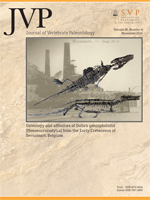New material from the Upper Devonian (Frasnian) Nordstrand Point Formation of Ellesmere Island, Nunavut, Canada, represents the largest known species of antiarch and the first described from the Nordstrand Point Formation. Bothriolepis rex, sp. nov., is additionally remarkable for the thickness and compactness of its dermal skeletal plates. The new species is diagnosed by a preorbital recess with a horizontal rostral margin; the presence of a wide unornamented border surrounding the infraorbital sensory line; central sensory lines that meet the margin of the nuchal close to the lateral corners; a supraotic thickening that does not extend caudal to a transverse crista of the nuchal; and a tall lateral lamina of the anterior dorsolateral. The thick and compact armor of Bothriolepis rex, sp. nov., recalls that of the co-occurring Perscheia pulla and gives occasion to a physical and ecological review of dermal skeletal mass and density in large-bodied, bottom-dwelling organisms in nonmarine ecosystems during the Late Devonian.
How to translate text using browser tools
1 November 2016
A New Large-Bodied Species of Bothriolepis (Antiarchi) from the Upper Devonian of Ellesmere Island, Nunavut, Canada
Jason P. Downs,
Edward B. Daeschler,
Valentina E. Garcia,
Neil H. Shubin
ACCESS THE FULL ARTICLE





